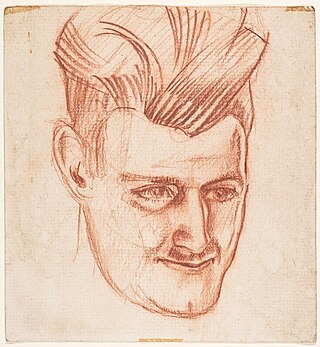Related Research Articles
Graham Vivian Sutherland was a prolific English artist. Notable for his paintings of abstract landscapes and for his portraits of public figures, Sutherland also worked in other media, including printmaking, tapestry and glass design.

Sir Stanley Spencer, CBE RA was an English painter. Shortly after leaving the Slade School of Art, Spencer became well known for his paintings depicting Biblical scenes occurring as if in Cookham, the small village beside the River Thames where he was born and spent much of his life. Spencer referred to Cookham as "a village in Heaven" and in his biblical scenes, fellow-villagers are shown as their Gospel counterparts. Spencer was skilled at organising multi-figure compositions such as in his large paintings for the Sandham Memorial Chapel and the Shipbuilding on the Clyde series, the former being a First World War memorial while the latter was a commission for the War Artists' Advisory Committee during the Second World War.
Frank Owen Dobson CBE was a British artist and sculptor and during his time was considered one of the best sculptors in Europe. He was a contemporary of Jacob Epstein and Henry Moore.

George Vernon Meredith Frampton was a British painter and etcher, successful as a portraitist in the 1920s–1940s. His artistic career was short and his output limited because his eyesight began to fail in the 1950s, but his work is on display at the National Portrait Gallery, Tate Gallery and Imperial War Museum.

Dame Laura Knight was an English artist who worked in oils, watercolours, etching, engraving and drypoint. Knight was a painter in the figurative, realist tradition, who embraced English Impressionism. In her long career, Knight was among the most successful and popular painters in Britain. Her success in the male-dominated British art establishment paved the way for greater status and recognition for women artists.
Charles Robert Owen Medley CBE, RA,, also known as Robert Medley, was an English artist who painted in both abstract and figurative styles, and who also worked as theatre designer. He held several teaching positions in both London and Rome.
Carel Victor Morlais Weight, was an English painter.

Eric Henri Kennington was an English sculptor, artist and illustrator, and an official war artist in both of the world wars.

Ethel Léontine Gabain, later Ethel Copley, was a French-Scottish artist. Gabain was a renowned painter and lithographer and among the founding members of the Senefelder Club. While she was known for her oil portraits of actresses, Gabain was one of the few artists of her time able to live on the sale of her lithographs. She also did etchings, dry-points, as well as some posters.
Roland Vivian Pitchforth RA ARWS was an English painter, teacher and an official British war artist during the Second World War. He excelled at watercolours and in later years concentrated on landscapes, seascapes and paintings of atmospheric effects.
Richard Ernst Eurich, OBE, RA was an English painter who worked as a war artist to the Admiralty in the Second World War and was also known for his panoramic seascapes and narrative paintings. These were often invested with a sense of mystery and wonder which have tended to set him apart from mainstream development of art in the twentieth century.
The War Artists' Advisory Committee (WAAC), was a British government agency established within the Ministry of Information at the outbreak of the Second World War in 1939 and headed by Sir Kenneth Clark. Its aim was to compile a comprehensive artistic record of Britain throughout the war. This was achieved both by appointing official war artists, on full-time or temporary contracts and by acquiring artworks from other artists. When the committee was dissolved in December 1945 its collection consisted of 5,570 works of art produced by over four hundred artists. This collection was then distributed to museums and institutions in Britain and around the world, with over half of the collection, some 3,000 works, going to the Imperial War Museum.
Dennis William Dring was a British portraitist.
Frances Macdonald, was an English painter known for her panoramic scenes painted in Wales, the south of France and in London during World War II.
Rupert Norman Shephard was an English painter, illustrator and art teacher.
Walter John Bayes was an English painter and illustrator who was a founder member of both the Camden Town Group and the London Group and also a renowned art teacher and critic.
Michael Ford was an English artist who worked in several media and whose paintings often have a somewhat naive quality coupled with elements of minute, detailed observation.
Raymond James Coxon was a British artist. He enrolled at the Leeds School of Art, the Royal College of Art, and became a teacher in the Richmond School of Art. The creative work of his long and successful career—singly and in various art groups—included landscape and portrait painting, abstract works, creating church murals and serving as a war artist during World War II. In particular he was known for the bold style of his figure and portrait work. After World War Two his paintings became more abstract.
Robin Craig Guthrie, was a British artist. He painted portraits, landscapes and murals and was also a draughtsman and book illustrator.
John Mansbridge (1901–1981) was a British artist. He was an official war artist during World War II and Head of Fine Art at Goldsmiths College in London.
References
- 1 2 3 4 Grant M. Waters (1975). Dictionary of British Artists Working 1900-1950. Eastbourne Fine Art.
- 1 2 3 4 David Buckman (1998). Artists in Britain Since 1945 Vol 1, A to L. Art Dictionaries Ltd. ISBN 0-95326-095-X.
- ↑ "Camouflage Screens at a Cheshire Factory". Imperial War Museums. Retrieved 14 June 2017.
- ↑ "Correspondence with artists:Barry Craig". Imperial War Museums. Retrieved 14 June 2017.
- ↑ "Cassis by Frank Barrington Craig". UK Government Art Collection. Archived from the original on 26 December 2017. Retrieved 14 June 2017.